Last updated: February 19, 2025
Article
"It Must Live Wherever It Can": Mural-Making in Latino Spaces (Teaching with Historic Places)
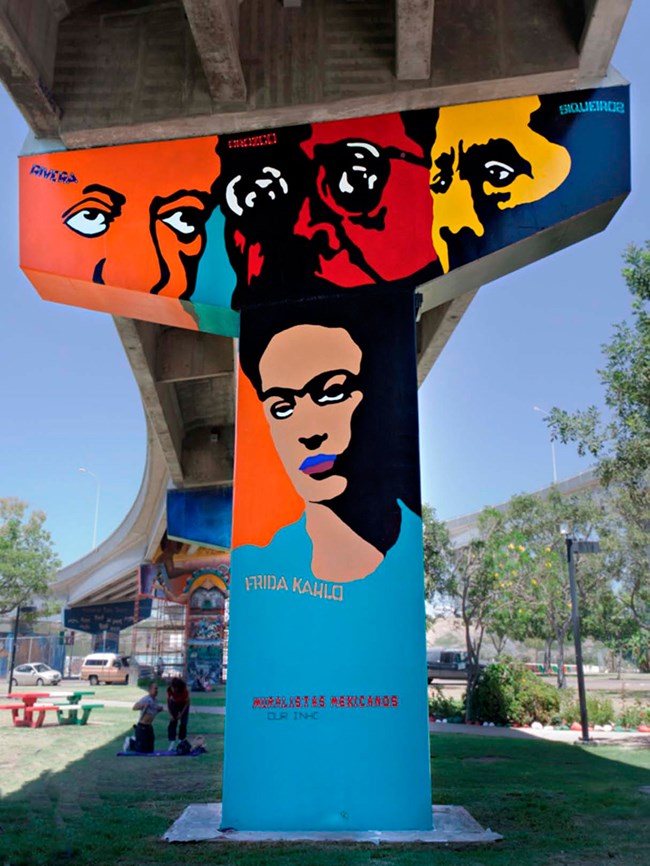
Copyright National Register of Historic Places.
Introduction
Los Angeles, Richmond, Chicago; more and more cities are celebrating the mural culture that local artists have been championing for generations. “Mural painting must help in [a person’s] struggle to become a human being, and for that purpose, it must live wherever it can,” Diego Rivera, one of the most well-known Mexican muralists, explained in 1934.[1]
In many Latino neighborhoods, murals are a way to claim space and create a dialogue about identity and belonging. Murals often reflect the work of the community, coordinated from planning to execution, especially in their placement in spaces claimed by the community. They are visible symbols of a group’s presence. Murals have deep historical roots in Latin America and elsewhere. Contemporary murals often express ethnic, religious, or racial pride, and many have social justice messages. For Latino neighborhoods, this may take the form of Indigenous or pre-colonial motifs, Catholic symbols, or heroic portraits of Historical Latino figures.
California cities like Los Angeles and San Diego have some good examples of Latino murals. These murals include The Great Wall of Los Angeles, where artist Judith Baca worked with community members to tell the story of California as Latino and Indigenous history over half a mile of mural. In San Diego, community members reclaimed urban space from highway development to create Chicano Park, a gathering space for the community with 72 murals depicting the Chicano Movement, actions done by Latino activists for equal rights and community empowerment in the 20th century.
African American, Native American and Indigenous peoples, and LGB communities also create murals to share their identity and history. While murals all share the large format and public presence, they depict a variety of artistic styles and cultures. When we look at these murals, we can see how communities celebrate their accomplishments, memorialize their pasts and advocate for the future.
About This Lesson
This lesson was written by Alison Russell, an intern with the Cultural Resources Office of Interpretation and Education. It is adapted from Places of Latino LGB Gathering Spaces. The article includes multiple sites on the National Register of Historic Places, such as The Women’s Building in San Francisco, The Great Wall of Los Angeles, and Chicano Park in San Diego. To learn more about the intersection of these histories, please visit the article.
Objectives:
- Identify elements of a mural and analyze their message
- Research individuals and symbols to determine their importance in a larger message
- Research national and/or local histories in order to communicate that history visually
- Plan a visual representation of a historical event or person through a mural
Topics and Time Period:
This can fit into a lesson on 20th century activism, the Chicano/a movement, Second Wave Feminism. It can also fit well into art courses of different mediums. While the lesson can serve as a stand-alone lesson for Hispanic Heritage Month, we encourage you to think about how these histories are interwoven with your larger curriculum.
United States History Standards for Grades 5-12
"It Must Live Wherever it Can” relates to the following National Standards for History:
Historical Thinking Standard 3: The student engages in historical analysis and interpretation:
-
Compare and contrast differing sets of ideas, values, personalities, behaviors, and institutions by identifying likenesses and differences.
-
Consider multiple perspectives of various peoples in the past by demonstrating their differing motives, beliefs, interests, hopes, and fears.
Historical Thinking Standard 4: The student conducts historical research:
-
Formulate historical questions from encounters with historical documents, eyewitness accounts, letters, diaries, artifacts, photos, historical sites, art, architecture, and other records from the past.
-
Obtain historical data from a variety of sources, including: library and museum collections, historic sites, historical photos, journals, diaries, eyewitness accounts, newspapers, and the like; documentary films, oral testimony from living witnesses, censuses, tax records, city directories, statistical compilations, and economic indicators.
-
Support interpretations with historical evidence in order to construct closely reasoned arguments rather than facile opinions.
United States Era 9: Post War United States (1945 to early 1970s)
Standard 4: The struggle for racial and gender equality and for the extension of civil liberties
United States Era 10: Contemporary *United States (1968-present)
Standard 2: Economic, social, and cultural developments in contemporary United States
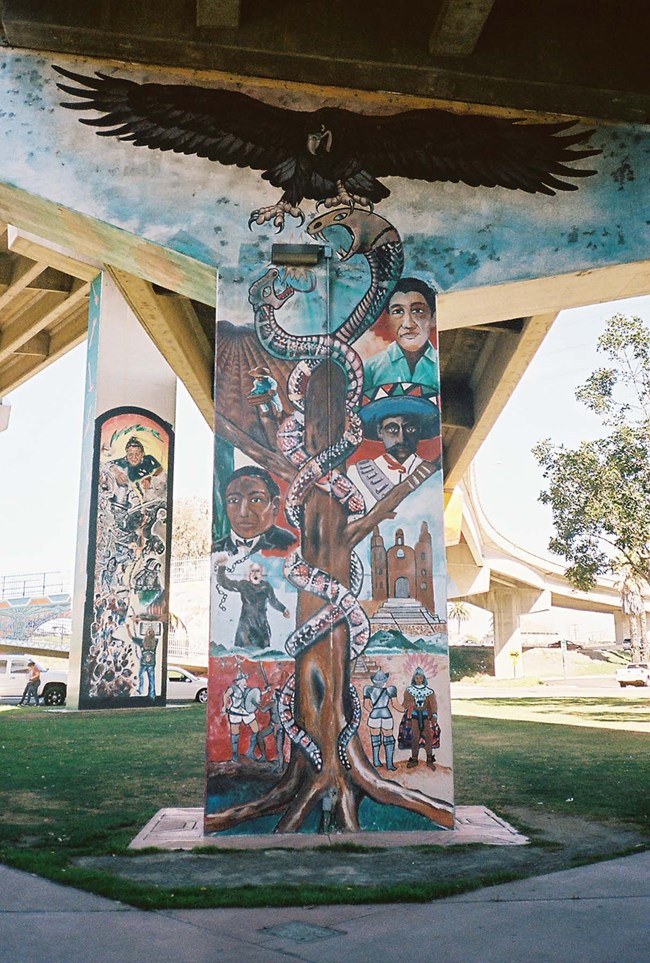
Copyright National Register of Historic Places.
Inquiry Question
How does the place-based and visual medium of murals uniquely communicate the history and culture of underrepresented voices?
Warm Up
Have students study this photograph of Chicano Park (Photo 2) in Barrio Logan, San Diego.
Ask students to think about and respond to:
-
What do you see in the image?
-
What does that teach you about the culture or community that created the mural?
-
How is the storytelling in this mural different from other ways you may learn about history?
Note: The following activities can be mixed and matched, expanded, or stand-alone based on curricular goals, grade level and time.
Activity 1: Explore a Mural (50 minutes)
The Women’s Building in San Francisco (Photo 3) is a site of intersectional, second-wave feminism. The murals on the outside of the building show the work of women’s movement artists from different racial and ethnic backgrounds, including Latina artists Juana Alicia and Irene Perez. All seven muralists brought their own cultures and perspectives to the outside of the building. Together, their work has a cohesive vision of feminism. Students will study and research the mural to determine what that message is.
Note: With some adjustments to the questions, this activity can be done for The Great Wall of Los Angeles using profiles by the National Park Service or New York Times; or Chicano Park using profiles by the Chicano Park Historical Documentation Project at San Diego State University or New York Times.
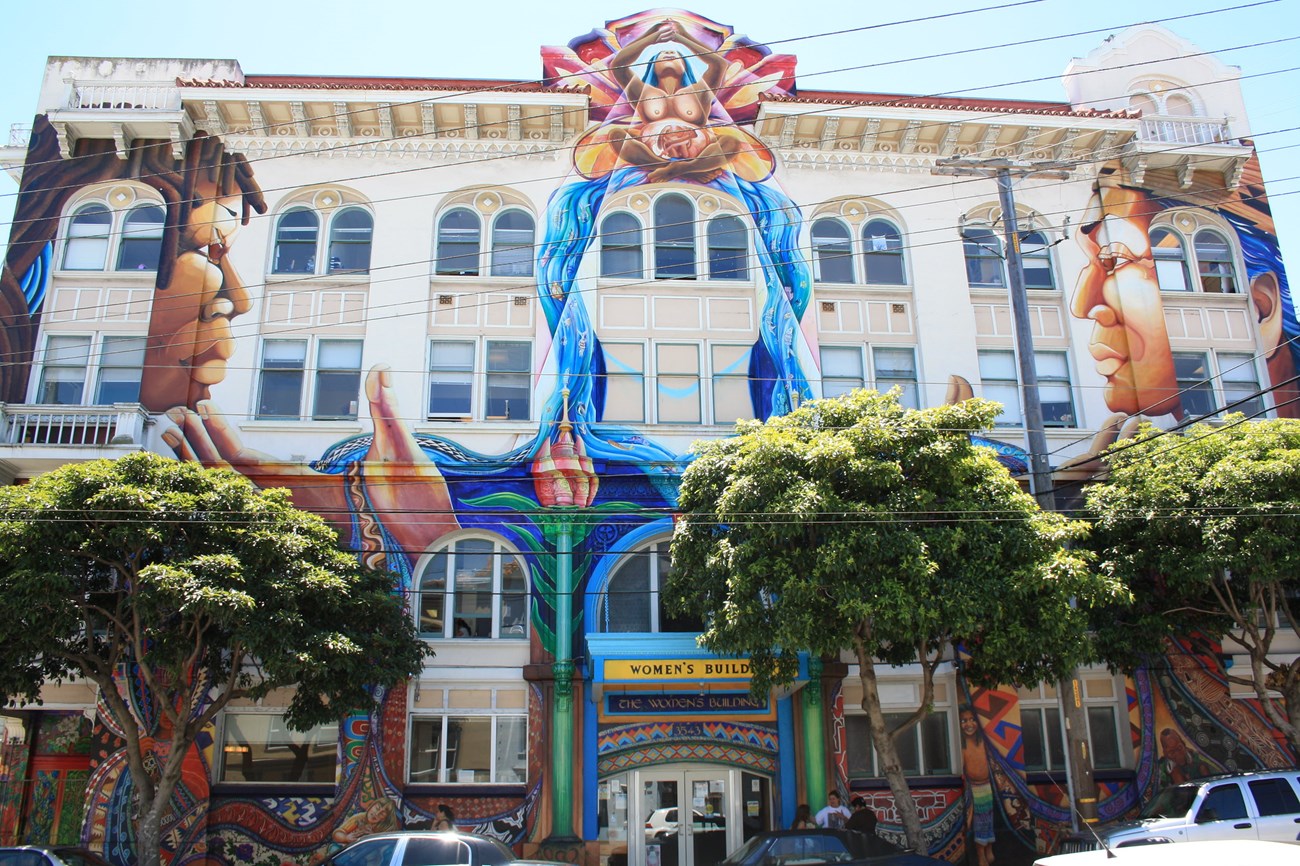
Photo by AbbyN. Attribution-NonCommercial-ShareAlike 2.0 Generic (CC BY-NC-SA 2.0). MAESTRAPEACE Mural by Juana Alicia, Edythe Boone, Miranda Bergman, Susan Cervantes, Meera Desai, Yvonne Littleton and Irene Perez, © 1994, 2000, 2010. All rights reserved.
1. Explore the website:
https://womensbuilding.org/the-mural/
Give students the time to learn a little bit about who made the mural on The Women’s Building and why. They may also want to explore the work that happens inside the Women’s Building. There is more information in this National Park Service Profile and on the artists' website.
2. Look closer:
Each student should choose a specific image (for example, the Gabon [Lumbu] Ancestor Mask or Olga Stornaouldo) that interests them. With a partner or individually, they should answer the following questions:
-
Describe what you see in this piece of the image.
-
How do you feel looking at this image? What colors, symbols, perspectives contribute to how this image makes you feel?
-
Form a Hypothesis: Why do you think the muralists included this image? What might this person or symbol contribute to a conversation about women’s, Latino, African American, Asian/Pacific Islander, and/or LGB histories?
3. Research:
Give students time to do some additional research about the person or symbol they chose. They should take notes on the following questions:
-
What/who are they? Consider their time and place of birth, their contribution to their community, any struggles they had to overcome, etc.
-
What connection do they have to women’s, Latino, African American, Asian/Pacific Islander, and/or LGB history?
-
Revise your hypothesis: Why do you think the muralists included this image? What might this person or symbol contribute to a conversation about women’s, Latino, African American, Asian/Pacific Islander, and/or LGB histories?
4. Present and Discuss:
-
Bring together the class or group. Students may formally or informally present what they learned about their image and how it might contribute to the message the artists were trying to send about women’s, Latino, African American, Asian/Pacific Islander, and/or LGB histories.
-
As students listen to other presentations, ask them to consider how they add to, complement, or contradict the student’s own thoughts about their piece of the mural.
-
Discuss the following questions as a whole class. Please prompt students to provide specific examples from both their own research and their classmates’.
-
What similarities did the various pieces have in common? Any differences?
-
How did the pieces work together to create a thematic whole? What do you think that theme is? Why?
-
What do you think the muralists were trying to communicate with this building? What makes you think so?
-
How does this mural approach history? How is it different from other ways of learning about history you may have experienced?
-
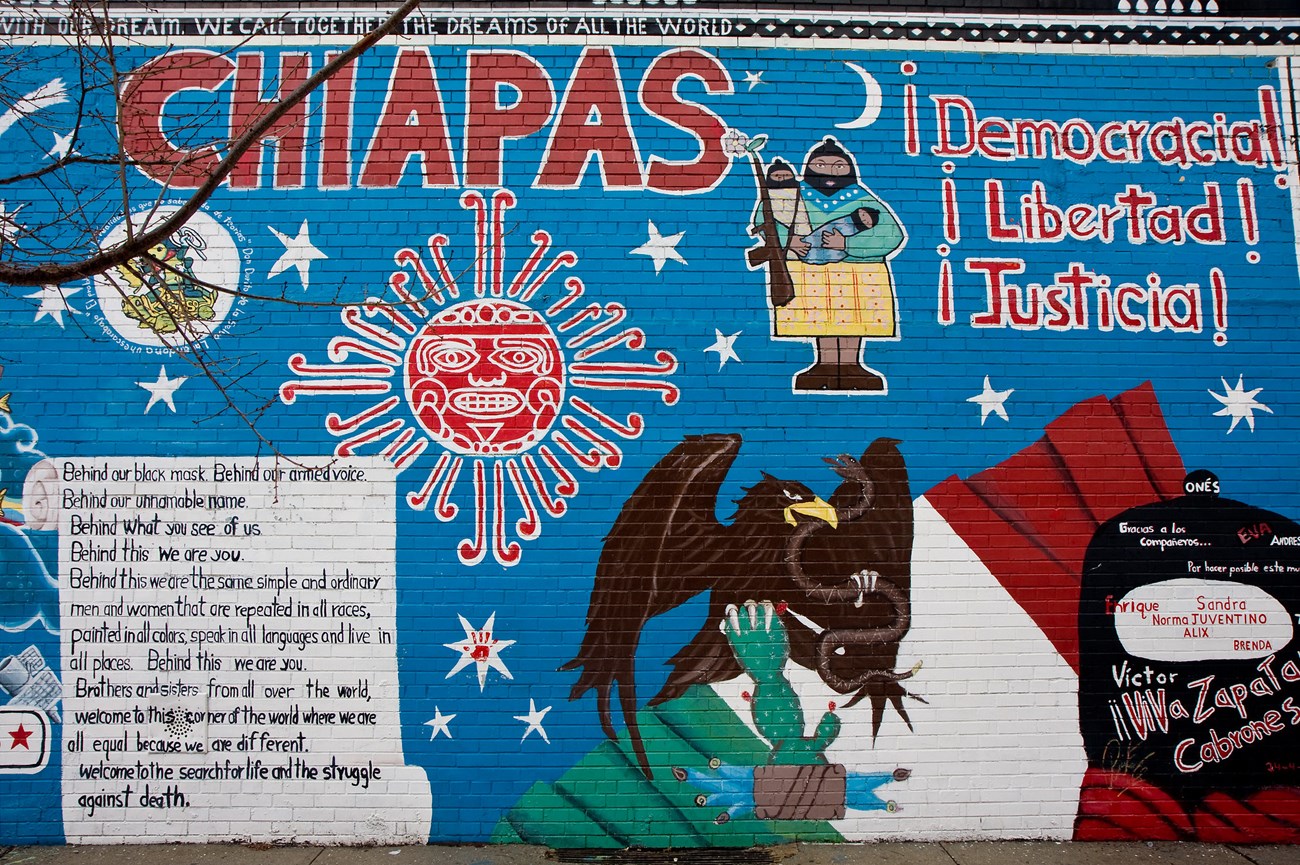
Photo by Garrett Ziegler, Attribution-NonCommercial-NoDerivs 2.0 Generic (CC BY-NC-ND 2.0).
Activity 2: Find a mural in your community (1 hour, 30 minutes)
Murals are a medium that allows for communities to assert their presence and identities in different ways. They tell a story differently than history textbooks or documentaries. Explore a mural in where you live and share what it says about your community’s identity.
Students can start on Wikipedia, a local historical or arts society, or on your town/city’s local government site. They can also use Google Maps and street view. Once they have identified a mural, students can do research to answer the following questions:
-
Who or what is depicted in the mural?
-
How are they depicted? What details in the image give you an idea of why the artist thinks the person or event is significant? What techniques does the artist use to make you feel a certain way about the person or event?
-
Do your own research on the person or event. What does your research support about the historical narrative in the mural? What does it add that is not in the mural? What does it contradict?
-
Reflect: Why do you think this mural is in your community? What does this mural teach about the history of your community that people wouldn’t otherwise know? Does it add to the community’s understanding of itself or help a group claim to this public space?
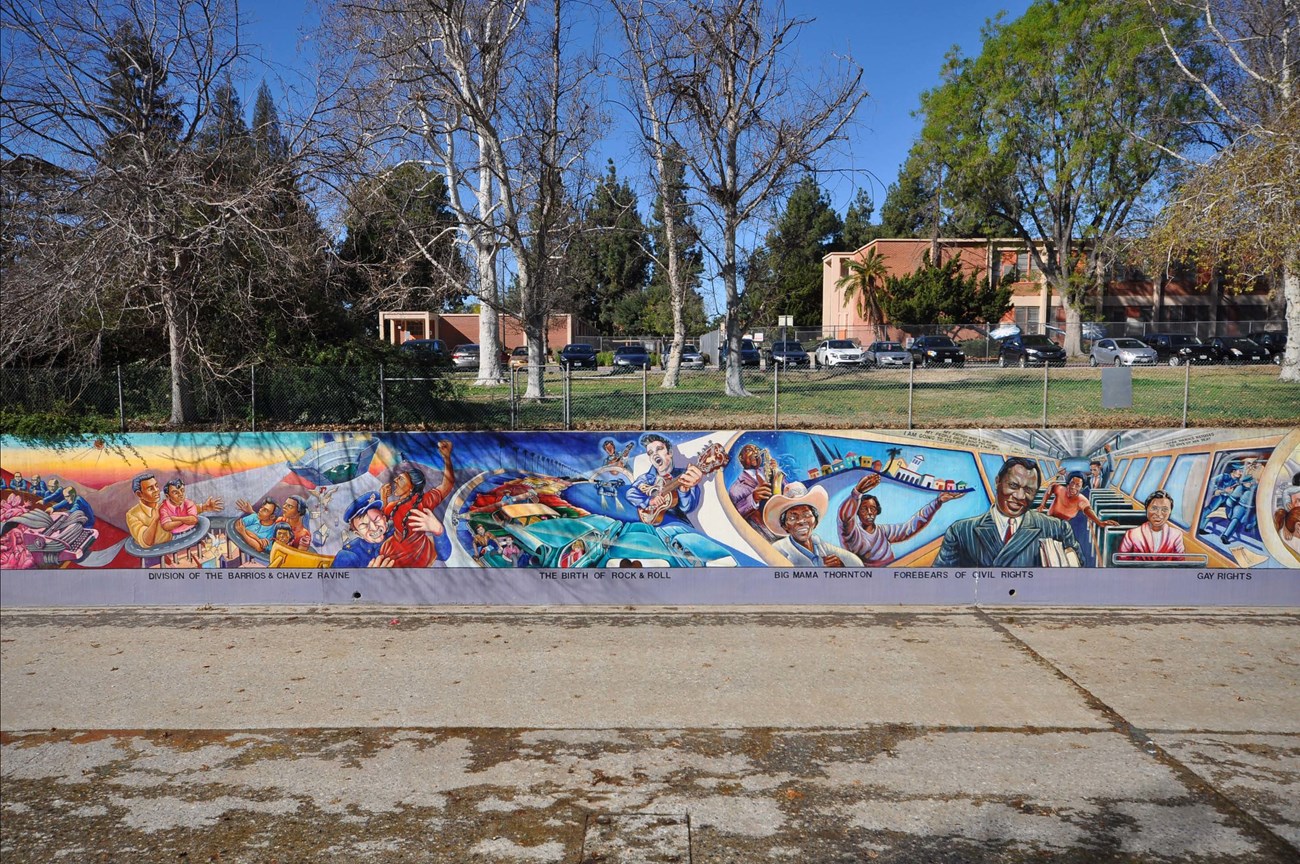
Photo Copyright National Register of Historic Places. Mural by Judith F. Baca©1983, SPARCinLA.org.
Activity 3: Create a Mural (student-led, class-dependent, multiple class sessions)
Young people have been integral to the planning and creation of many murals, in Latino communities and others. Artist Judy Baca, for example, worked with local teenagers to paint The Great Wall of Los Angeles, both to help her paint and to talk about what stories should be told. Conversations and planning with the community, as well as an awareness of place and space, make murals a unique form of storytelling.
1. Explore:
Have students, thinking about mural making generally, look at the following resources about The Great Wall of Los Angeles: National Park article, a PBS video profile and/or a New York Times profile of Judy Baca. They can also watch this scan of the wall accompanied by a poem about it. As they do, they should take notes on the following questions and the class may discuss them altogether.
-
What was Baca (the artist’s) purpose in creating the mural? How did that impact her decisions about content?
-
What events are portrayed in the mural? What people? How does that tell a story of California? Is that the same story that people may learn elsewhere (like in school)?
-
How does it communicate its message? How is a mural different from other ways of communicating knowledge? How is space important?
2. Research:
Allow each student to explore a historical event in your community. A great place to start may be your town’s Wikipedia page or see if your town has a Historical Society. Students should choose an event that represents something they value about their community or something they believe should be remembered. As students research, they should make notes on:
-
Who was involved?
-
Where and when was it?
-
What happened?
-
What was the struggle? To what extent did people overcome the challenge?
-
How did it change the town/community that you live in?
-
How is it important to you and members of your community? Why should other people know about this person/event?
3. Plan:
Murals have a different presence and thus different planning from other types of art or communication. Students should think about scale, about the building and space that it will be painted (or applied) to and who is walking by. Murals come in a variety of artistic styles but they need to convey a lot of information quickly to those walking or driving by. For further thinking about murals watch the PBS video linked above.
-
Look at different examples of murals, independently or as a class. Student think about what they like and they you don’t like.
-
Students will plan and sketch a visual representation of your person or event. As they do, consider:
-
Do you want a literal (realistic) or symbolic representation?
-
How will you show action or the passage of time (if at all)?
-
What colors or symbols help convey the emotion and meaning of your mural?
-
How could you respond to windows, bricks, or other features of the building?
-
- Students may then present, formally or informally, their plan with others. They should explain the visual decisions they made and how the images celebrate, memorialize or advocate change based on a historical event or person in your community.
Extension:
If you would like, put this mural into action. This can be done in a number of ways, but doing so will involve mathematics (for scaling your plan up to the size of building and for creating a budget), research, collaboration, research and most importantly communication. Murals are community efforts, and you will need to make connections in your community to be successful.
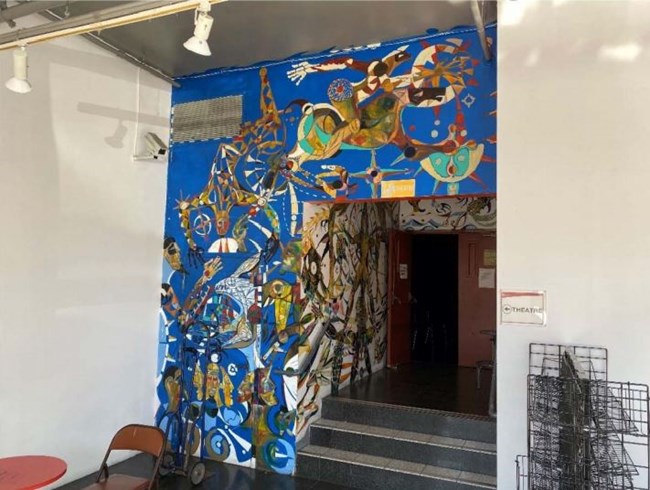
Copyright National Register of Historic Places.
Further Reading
Continue to explore Latino-heritage murals through the National Park Service by reading about Nuestra Herencia Mural in Texas, The Epic of American Civilization Murals in New Hampshire, the Detroit Industry Murals in Michigan, Chicano Park in San Diego, and many others.
This Library of Congress blog celebrates murals for Hispanic Heritage Month and the photographer, Carol Highsmith, who documented many of them across the country.
An article from Smithsonian Magazine tells the story of community members’ efforts at Chicano Park in San Diego, not only to create the original space but how that space continued to contribute to the neighborhood.
To see more great murals and explore their history, check out this Google Arts and Culture story about Latino Murals.
Endnotes
[1] Melvin Delgado and Keva Barton, "Murals in Latino Communities: Social Indicators of Community Strengths," Social Work 43, no. 4 (1998): 346–356. http://www.jstor.org/stable/23718686.
